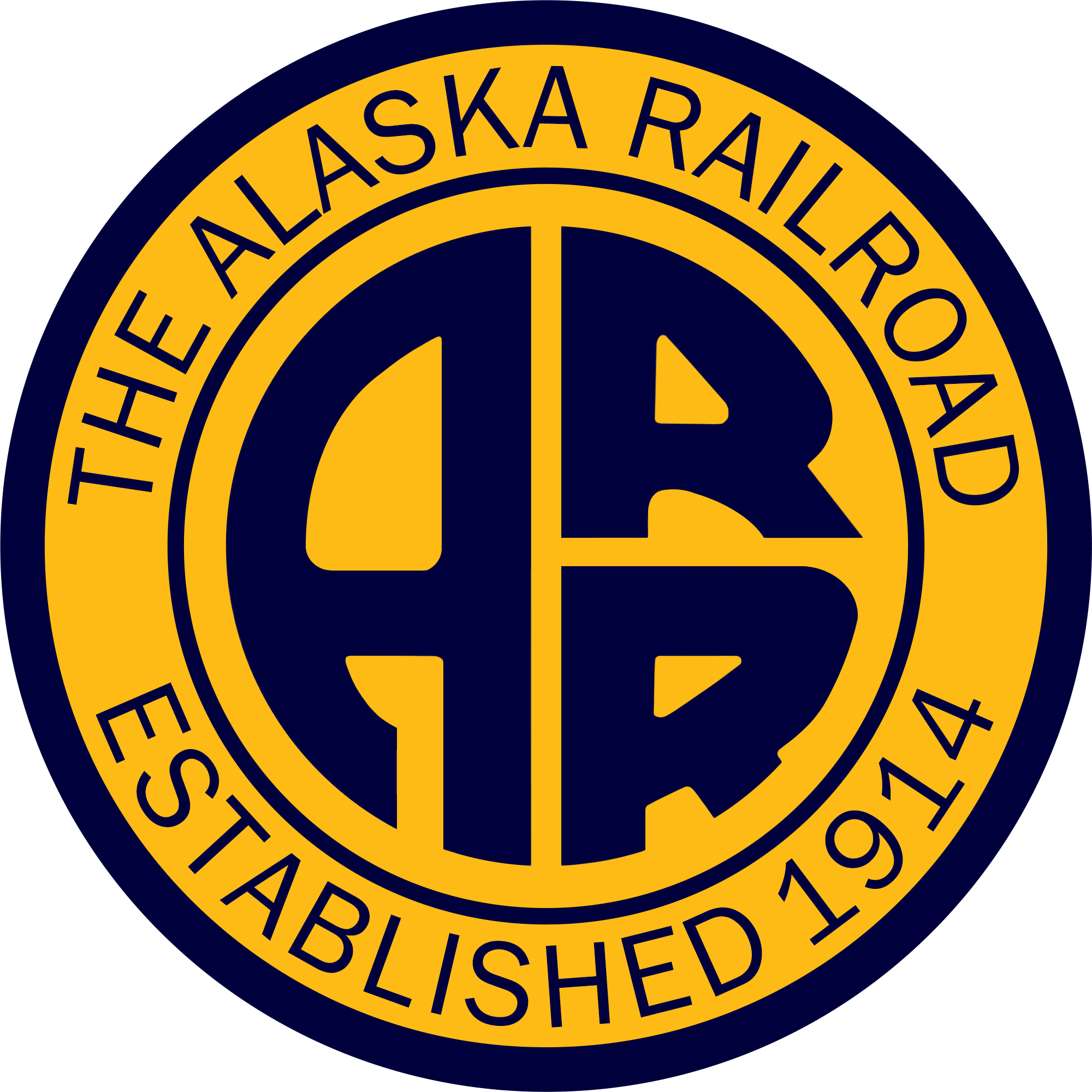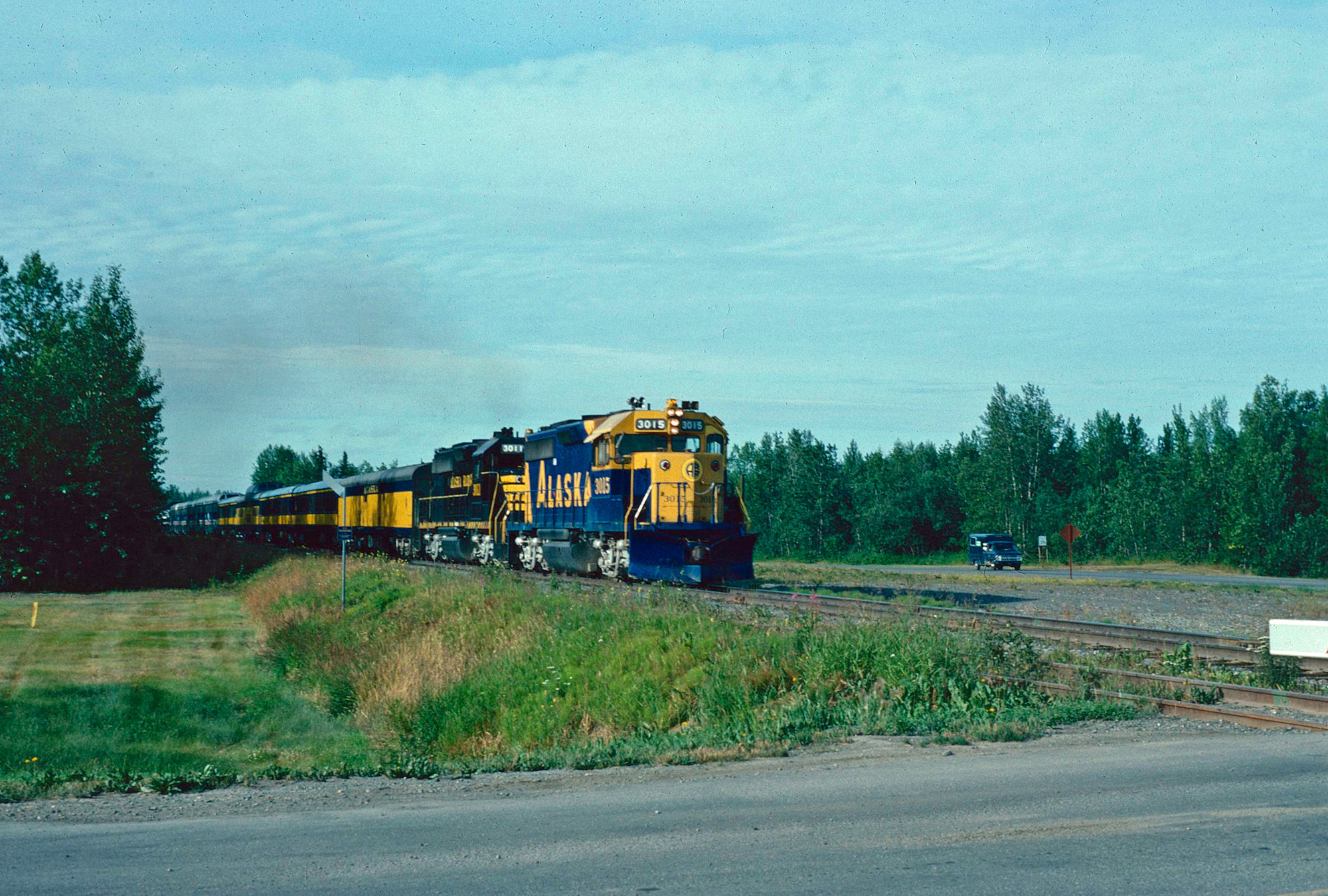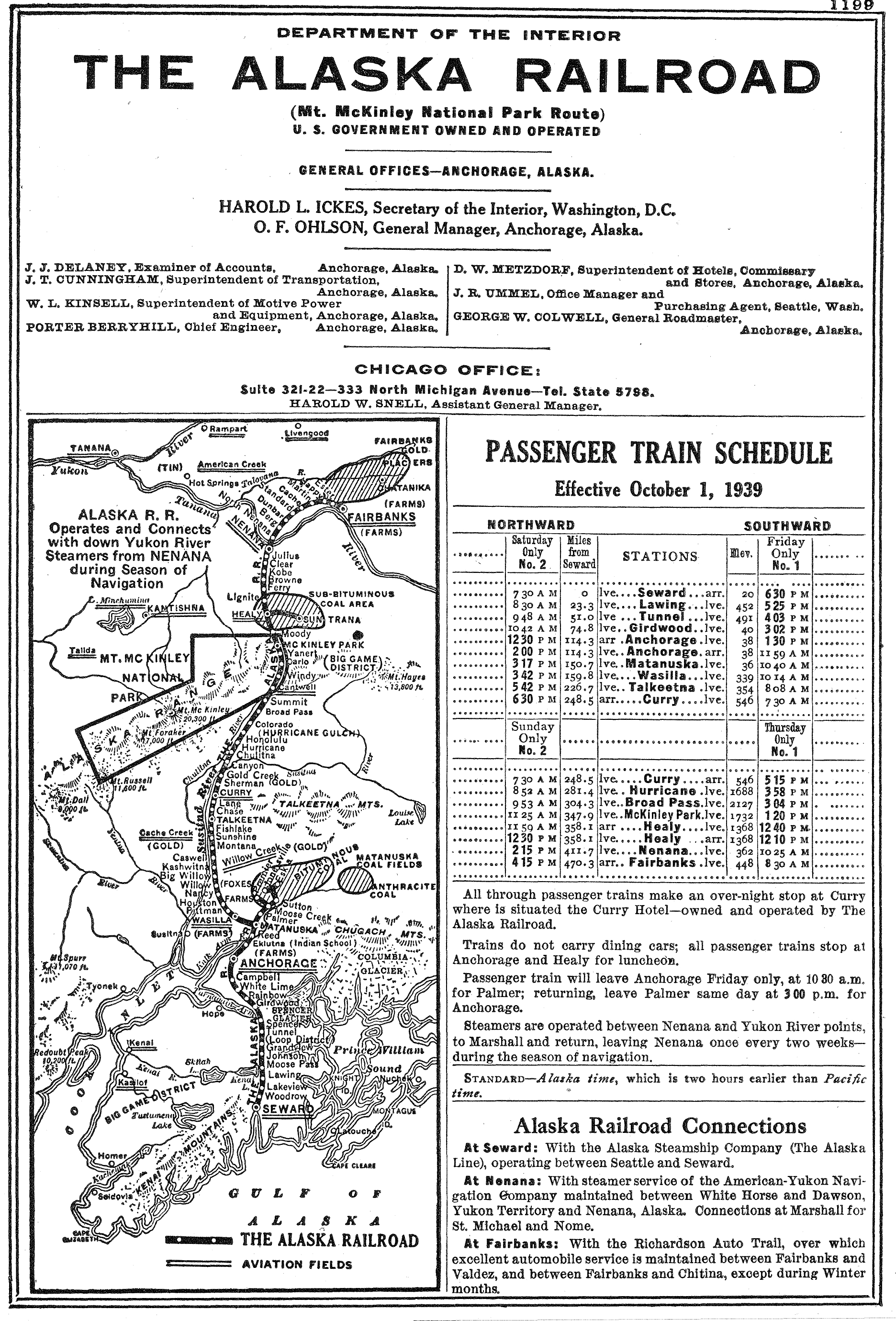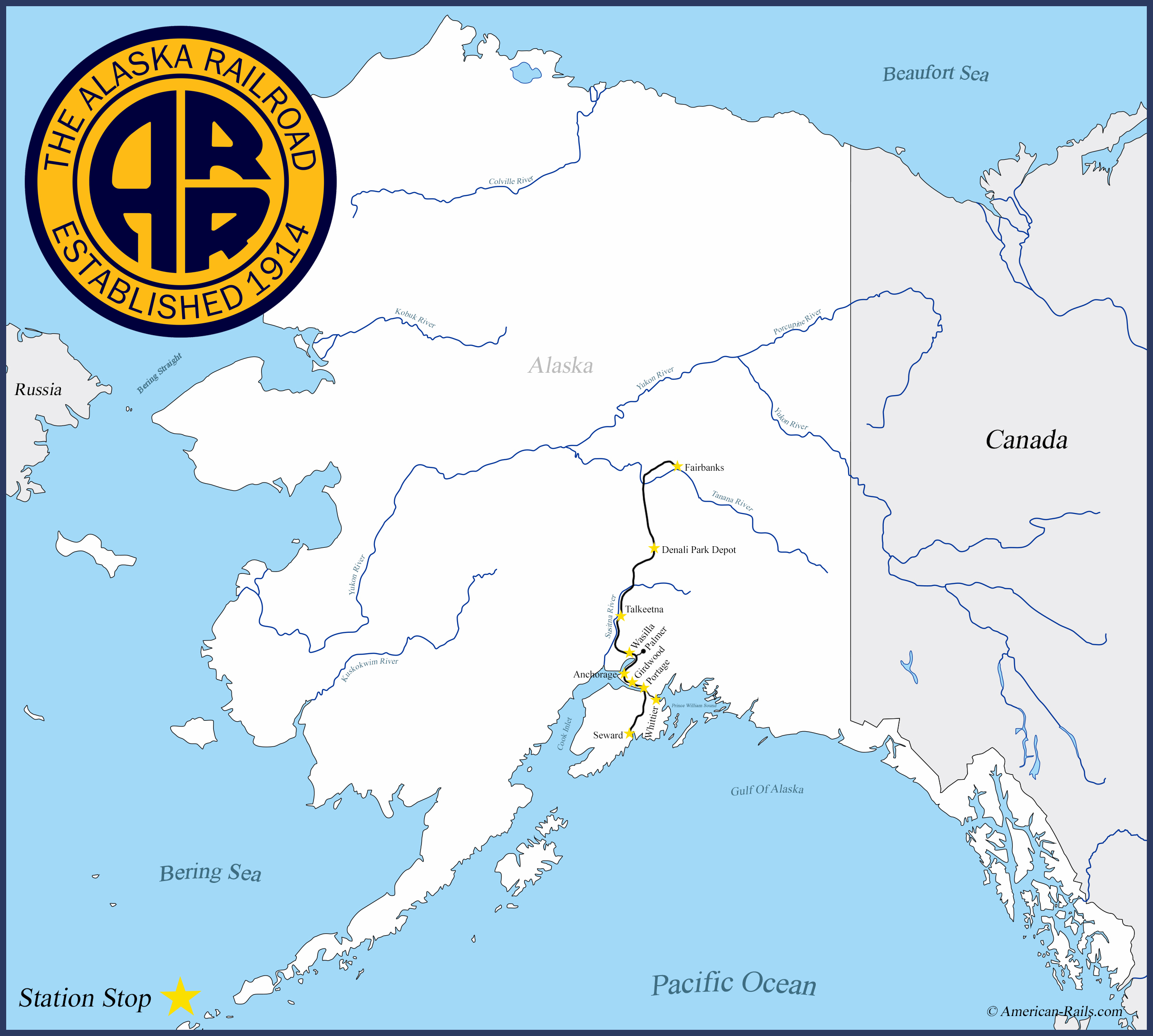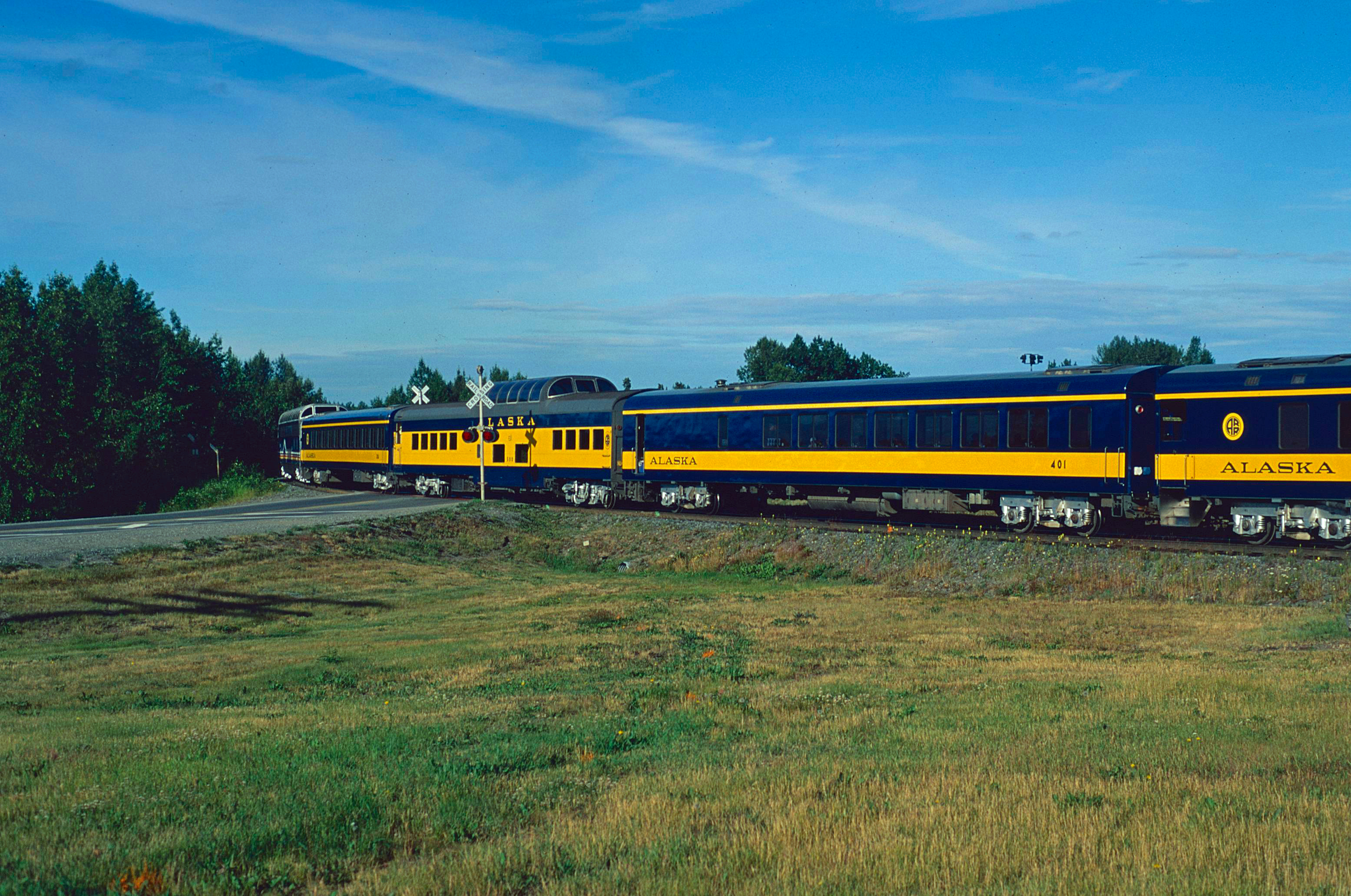Alaska Railroad: Tours, Map, Schedule, Roster, History
Last revised: February 24, 2025
By: Adam Burns
Sometimes a forgotten carrier because of its location, the Alaska Railroad (ARR) is a Class II, regional carrier operating nearly 400 route miles.
Its lines are essentially a single mainline stretching from Seward in the south to Fairbanks in the north. Since its beginnings in the early 1900s the railroad has done much to bring prosperity to a region and state that lacks infrastructure.
It has been a vital asset in moving freight and passengers for more than a century and perhaps one day can finally be linked to the North American rail network.
If so, the railroad would transform into a major artery that would likely see all the largest cities along its route soar to new economic heights. Today the Alaska Railroad is owned by the State of Alaska after operations were handed over from the federal government.
Photos
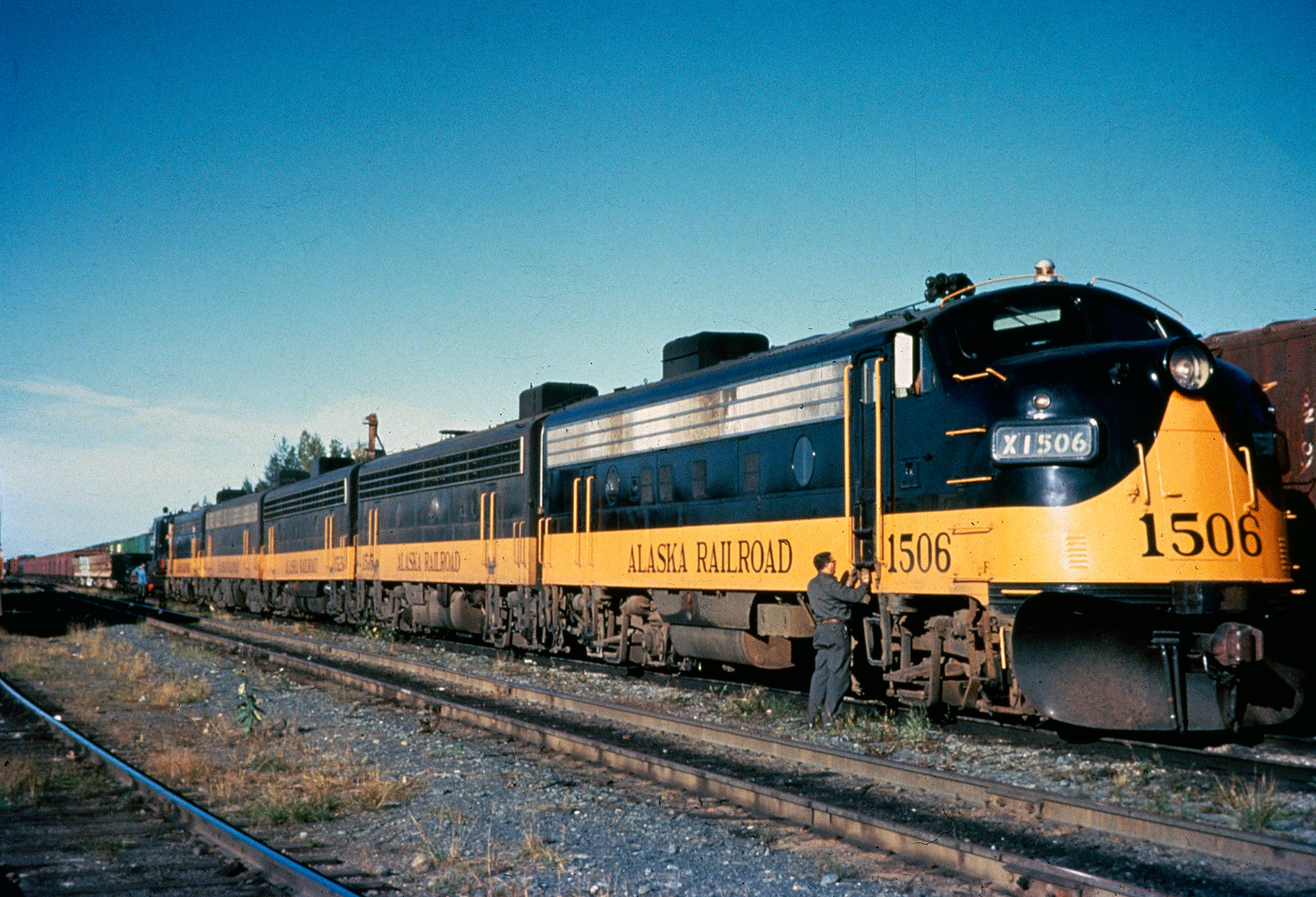 Alaska Railroad F7A #1506, F7B #1503, F7B #1525 (ex-Rio Grande #5653), F7B #1517 (ex-Rio Grande #5552/#555-B), and F7A #1504 ready to depart from Anchorage on September 18, 1971. Author's collection.
Alaska Railroad F7A #1506, F7B #1503, F7B #1525 (ex-Rio Grande #5653), F7B #1517 (ex-Rio Grande #5552/#555-B), and F7A #1504 ready to depart from Anchorage on September 18, 1971. Author's collection.History
It is one of the few private railroads to continue hosting passenger trains regularly with equipment adorned in a beautiful dark blue and yellow livery with "ALASKA" proudly flanking locomotives and cars.
Tourism has blossomed into a significant aspect of the railroad's operations. With so many folks now flocking to see Alaska's incredible natural beauty by either cruise, plane, or even vehicle along Highway 1 many also book trips by train to further this experience.
As such, the railroad has several different vacation packages available. Presented here is a brief history of the Alaska Railroad as well as current operations, including the tours it offers.
Construction
The State of Alaska's rail heritage dates back to 1898 when the White Pass & Yukon Route Railroad opened its 111-mile line between Skagway and Whitehorse, Yukon Territory (Canada).
However, this narrow-gauge operation was largely local in nature to serve the booming Klondike Gold Rush of 1897. It later transitioned into handling copper, silver, and lead ore which continued until October 7, 1982 when freight operations ceased.
The railroad would likely have been abandoned if not for the tourism industry and has flourished in that role ever since.
Alaska Central
The then-Alaska Territory's introduction to standard-gauge railroads began with the Alaska Central Railroad (AC), which opened 51 miles north from Seward in 1909.
While the AC's only important connection was at Steward, service to the port city was nonetheless a vital transportation artery for a region that was so rugged even viable horse trails and roads were scarce.
Unfortunately, with limited online business the railroad went bankrupt and was reorganized as the Alaska Northern Railway in 1909.
Alaska Northern
The Alaska Northern extended the system to Kern Creek along Turnagain Arm, 71 miles from Seward, by 1910. In his book, "High Iron To Fairbanks: A Novel," author Evan McKinney details the Alaska Railroad's genesis.
Following the Alaska's formal organization as a United States territory on August 24, 1912 the federal government put into motion efforts to open up the region to trade and exploration.
Spearheaded by President Woodrow Wilson the Department Of The Interior formed the Alaska Engineering Commission to begin surveying routes.
Led by Tom Riggs, Lieutenant Frederick Mears (who worked as engineer for the Great Northern Railway and helped build the Panama Railroad), and William Edes, two routes were ultimately chosen:
- The Eastern Route would begin from the coast at either Cordova or Valdez and continue north using the Copper, Tonsina, Delta, and Tanana Rivers.
- The Western Route would travel northward from Seward and around Cook Inlet before splitting Broad Pass and reaching Fairbanks.
Logo
The project carried three stipulations; it could not extend further than 1,000 miles, connect at least one Pacific harbor with northern coal fields, and exceed $35 million.
To accomplish the latter and reduce construction costs the Alaska Northern was purchased.
The railroad was projected to extend a total of 473 miles with a branch extending northeasterly from the Knik Arm and running along the Matanuska River to serve coal lines in the river valley (this 38-mile branch, completed in 1917, has largely since been abandoned north of Palmer).
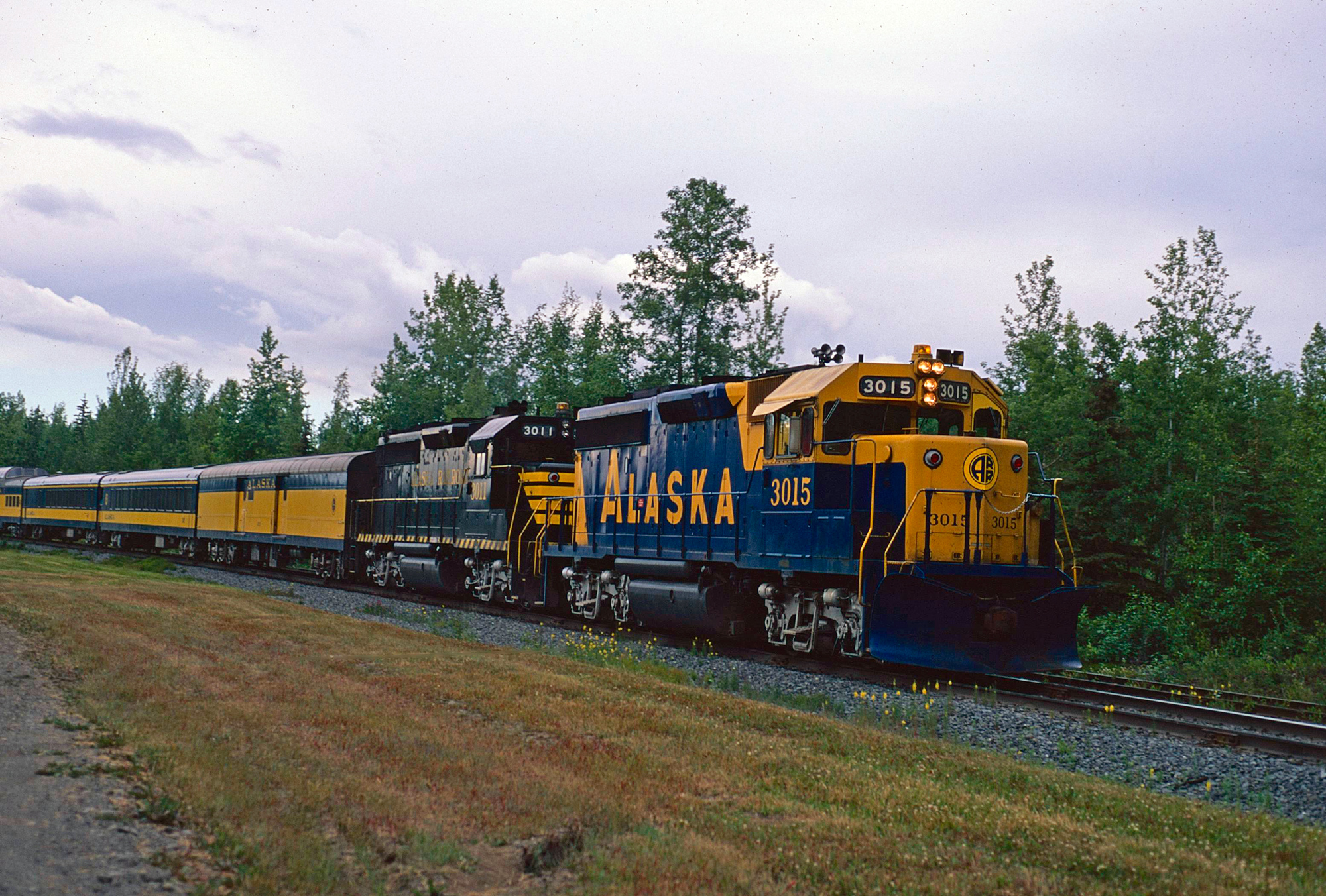 A pair of Alaska Railroad GP40-2's lead one its passengers trains on July 16, 1994. Author's collection.
A pair of Alaska Railroad GP40-2's lead one its passengers trains on July 16, 1994. Author's collection.It was at Ship Creek where Mears established the railroad's primary deep-water construction port where materials, supplies, and men were off-loaded from marine ships.
It quickly grew into a tent city and eventually led a townsite plotted which officially became Anchorage, on November 23, 1920. Today, it is Alaska's largest city. Major construction of the railroad began in 1916, bogged down in part by the ongoing Great War in Europe (World War I).
Tours/Schedule
The ARR currently offers five different scheduled passenger trains along its system which include the Denali Star, Coastal Classic, Glacier Discovery, Hurricane Turn (Summer And Winter versions), and the Aurora Winter Train.
The company also enjoys a bustling tourism business during the summer season. If you have the means for such a vacation, an excursion on this railroad should be a bucket list item!
While the summer season is always their busiest you can catch a train ride year round although the schedule is truncated largely to weekends only and on select dates throughout the winter.
Finally, be sure to book a special event train for the holidays and other noteworthy seasons.
These include:
- The Ski Train
- Easter Train
- Fair Train (Alaska State Fair)
- Fairbanks Family Fun Train
- Hoodoo Choo Choo
- Kid's Halloween Train
- Holiday Train
To book your vacation aboard the Alaska Railroad please click here to visit their website.
Another significant setback occurred on January 22, 1916 when a severe fire destroyed the railroad's wharf in Seward.
Even by the standards of day, which in railroading were quite modern during the 1910's, building a railroad in such a rugged, undeveloped wilderness was truly like stepping back a half-century to the Transcontinental Railroad's construction of the 1860's.
"The Last Frontier" was unforgiving due to the weather, terrain, and lack of established facilities. There were no cities of significance in Alaska at the time and all materials had to shipped from Seattle.
The railroad was constructed from both ends; the northern segment was largely completed to Fairbanks by 1917 following the purchase of the narrow-gauge, 45-mile Tanana Valley Railroad (TVRR).
This system was built primarily to serve the gold rush. Its interest by the Alaska Railroad was for terminal facilities along the Tanana River near Fairbanks.
Operated as the Chatanika Branch much of the TVRR was abandoned in 1930. The route to Fairbanks was not officially completed until the 700-foot, Mears Memorial Bridge across the Tanana River at Nenana on July 15, 1923.
Timetable (1939)
Formation
The southern segment (Anchorage-Turnagain Arm) was finished shortly after the Tanana Valley Railroad acquisition when the final rail was laid on September 17, 1918.
From that point, forward, the task of linking Anchorage and Fairbanks began. After the purchase of the Tanana Valley Railroad it took construction crews six years to link the two cities completing the line, officially, on July 15, 1923.
In the end, as is nearly always the case, final construction costs far exceed expectations. When accounts tabulated the numbers the Alaska Railroad had cost more than $56 million and fiscal year's end in 1923 (June 30th) noted profits covered less than half of operating costs.
This did not even factor in maintenance and general expenses, which showed even greater losses for the project. Despite this, the new railroad, and those who oversaw its construction, were able to see it finished and provide the territory/state a much needed infrastructure improvement.
System Map
By 1944 with the establishment of a second port at Whittier, the Alaska Railroad was all but complete and has changed little over the last 70+ years.
The ARR became state owned in the 1980s when President Ronald Reagan, in 1983, signed legislation transferring ownership of the railroad to the State of Alaska.
The transfer was official on January 5th, 1985 when on that day the ARR came under ownership by the state.
The state spent $22.3 million to purchase the railroad although the final price tag was nearly $100 million as Alaska had to spend an additional $70 million bringing the right-of-way up to proper standards due to many years of deferred maintenance.
In all, the Alaska's system runs roughly due north winding its way from Seward in the south to Eielson in the north, where the Alaska serves the Eielson Air Force Base.
And, currently the Alaska Railroad’s roster consists entirely of EMD power from two F40PHs to more than two-dozen almost-new SD70MACs. Throughout the years the Alaska had a wide range of steam and diesel locomotives. Its current roster is listed below
Locomotive Roster
| Builder | Model Type | Road Number | Notes/Disposition | Quantity |
|---|---|---|---|---|
| EMD | Power Cab | 31-32 | Ex-Amtrak F40PHs | 2 |
| EMD | GP38-2 | 2001-2008 | Ex-PC, Ex-BA&P | 8 |
| EMD | GP40-2 | 3001-3008, 3012-3015 | Unknown | 12 |
| EMD | GP40-2HEP | 3009-3011 | Unknown | 3 |
| EMD | SD70MAC | 4001-4028 | Purchased New, 1999-2007 | 28 |
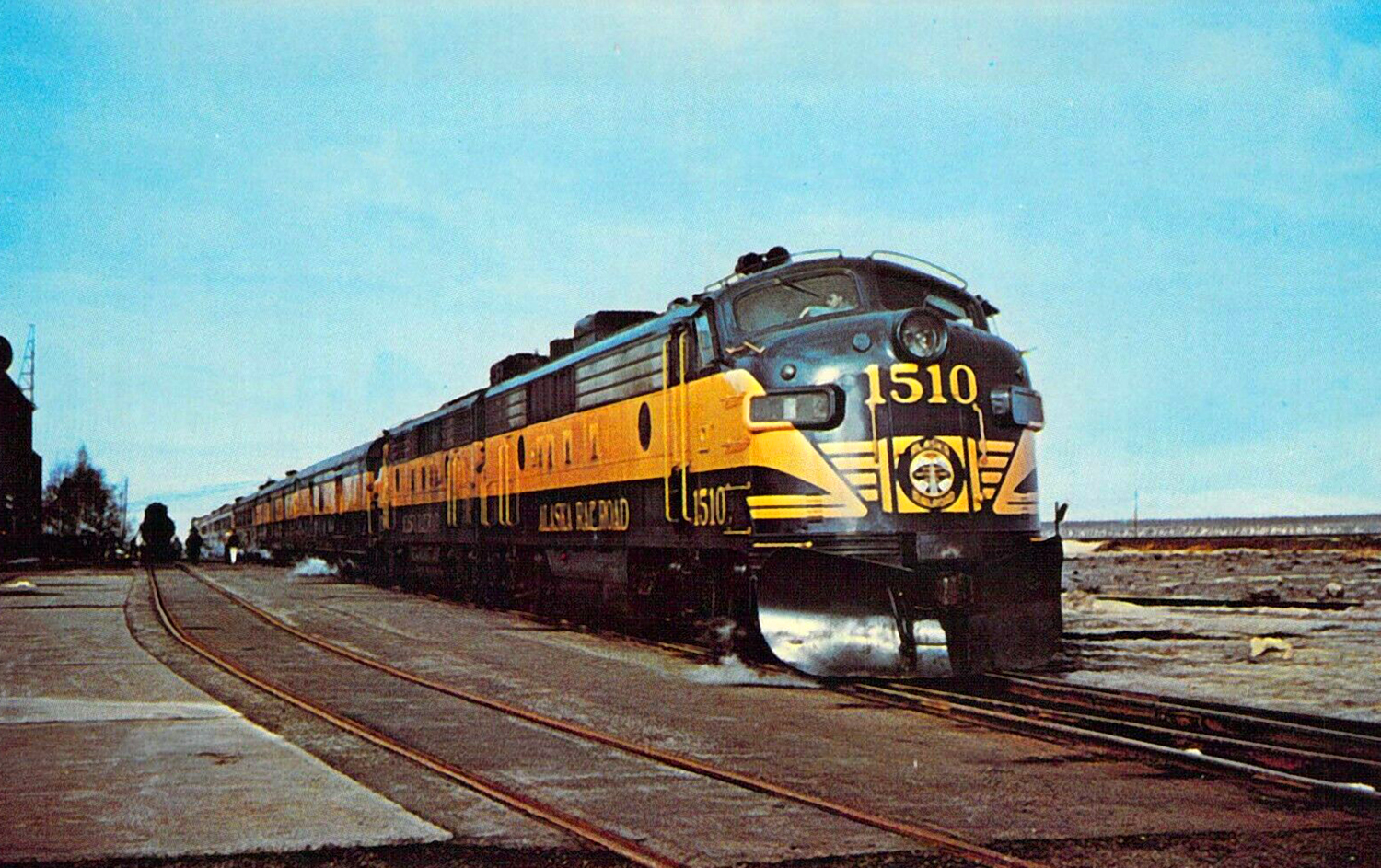 A pair of Alaska Railroad FP7's have the "Aurora" (Anchorage - Fairbanks) awaiting departure from the station in Anchorage, Alaska on April 11, 1964. This was the first train to run north from the city after the severe earthquake of March 27th that year (Good Friday).
A pair of Alaska Railroad FP7's have the "Aurora" (Anchorage - Fairbanks) awaiting departure from the station in Anchorage, Alaska on April 11, 1964. This was the first train to run north from the city after the severe earthquake of March 27th that year (Good Friday).Future
For years there have been discussions of linking the Alaska Railroad with the North American rail network. To date the Canadian and American governments have never ponied up the needed billions to realize this connection.
However, there finally appears to be a proverbial light at the end of the tunnel thanks to President Donald Trump. News broke in September, 2020 that he had issued a Presidential Border Crossing Permit (presidential permit) to build the Alaska-Alberta Railway (A2A).
The $17 billion project is expected to begin construction in 2020 and be fully operational by 2026. The new railroad, running from Fort McMurray, Alberta to Delta Junction, Alaska will cover an impressive 1,600 miles.
This new railroad will likely greatly expand the economies of Alaska and the Canadian territories through which it passes by allowing a free flow of freight from the Gulf of Mexico to the Gulf of Alaska.
It is expected to generate $60 billion in additional cumulative GDP through 2040 and create more than 28,000 jobs. Perhaps most importantly, the Alaska Railroad will finally be linked to the rest of North America.
Recent Articles
-
Indiana's Dinner Train Rides In Jasper!
Jan 18, 26 01:54 PM
In the rolling hills of southern Indiana, the Spirit of Jasper offers one of those rare attractions that feels equal parts throwback and treat-yourself night out: a classic excursion train paired with… -
New Mexico's Dinner Train Rides
Jan 18, 26 01:37 PM
If your heart is set on clinking glasses while the desert glows at sunset, you can absolutely do that here—just know which operator offers what, and plan accordingly. -
New Hampshire ~ Murder Mystery ~ Dinner Train Rides
Jan 18, 26 01:10 PM
The state's murder mystery trains stand out as a captivating blend of theatrical drama, exquisite dining, and scenic rail travel. -
New York Valentine's Train Rides
Jan 18, 26 12:32 PM
At its best, the Adirondack Railroad delivers exactly what railfans and casual riders alike hope for: vintage coaches, classic depots, rivers and forests right outside the window. -
Washington Valentine's Train Rides
Jan 18, 26 10:50 AM
Whether you’re a dedicated railfan chasing preserved equipment or a couple looking for a memorable night out, CCR&M offers a “small railroad, big experience” vibe—one that shines brightest on its spec… -
Colorado Valentine's Train Rides
Jan 18, 26 10:49 AM
The Royal Gorge Route Railroad is the kind of trip that feels tailor-made for railfans and casual travelers alike, including during Valentine's weekend. -
Georgia Valentine's Train Rides
Jan 18, 26 10:42 AM
f you’ve ridden the SAM Shortline, it’s easy to think of it purely as a modern-day pleasure train—vintage cars, wide South Georgia skies, and a relaxed pace that feels worlds away from interstates and… -
New Jersey ~ Murder Mystery ~ Dinner Train Rides
Jan 17, 26 01:16 PM
There are currently no murder mystery dinner trains available in New Jersey although until 2023 the Cape May Seashore Lines offered this event. Perhaps they will again soon! -
West Virginia Dinner Train Rides In Elkins!
Jan 17, 26 01:08 PM
The D&GV offers the kind of rail experience that feels purpose-built for railfans and casual travelers. -
Virginia Dinner Train Rides In Staunton!
Jan 17, 26 11:55 AM
If you’ve ever wished you could pair a classic scenic train ride with a genuinely satisfying meal—served at your table while the countryside rolls by—the Virginia Scenic Railway was built for you. -
Florida Easter Train Rides
Jan 17, 26 10:23 AM
The cold weather rarely invades Florida and the state nearly always warm and balmy early spring temperatures. Learn more about where you can find Easter-themed train rides across the Sunshine State. -
Ohio Easter Train Rides
Jan 17, 26 10:13 AM
Ohio is home to several museums and excursion trains preserving the state's rich railroading heritage. A few of these locations host Easter-themed train rides each spring. -
Massachusetts Valentine's Train Rides
Jan 17, 26 09:58 AM
The Cape Cod Central Railroad (CCCR) blends classic New England scenery with heritage equipment, narrated sightseeing, and some of the region’s best-known “rails-and-meals” experiences. -
California Valentine's Train Rides
Jan 17, 26 09:53 AM
Operating out of West Sacramento, this excursion railroad has built a calendar that blends scenery with experiences—wine pours, themed parties, dinner-and-entertainment outings, and seasonal specials… -
South Carolina Dinner Train Rides
Jan 16, 26 11:13 PM
There is only location in the Palmetto State offering a true dinner train experience can be found at the South Carolina Railroad Museum. Learn more here. -
Rhode Island Dinner Train Rides
Jan 16, 26 11:01 PM
Despite its small size, Rhode Island is home to one popular dinner train experience where guests can enjoy the breathtaking views of Aquidneck Island. -
Pennsylvania's Thomas The Train Rides
Jan 16, 26 04:13 PM
"A Day Out With Thomas” train rides offer a unique opportunity for children and their families to engage in a magical and memorable experience, setting the stage for a full day of fun and adventure. -
Illinois's Thomas The Train Rides
Jan 16, 26 02:23 PM
In Illinois, the "A Day Out With Thomas" event offers a unique chance for families to immerse themselves in the enchanting world of Thomas and friends, creating memories that last a lifetime. -
New Jersey's Thomas The Train Rides
Jan 16, 26 02:11 PM
Here's a comprehensive guide to what you can expect at Day Out With Thomas events in New Jersey. -
Texas ~ Murder Mystery ~ Dinner Train Rides
Jan 16, 26 01:54 PM
Here’s a comprehensive look into the world of murder mystery dinner trains in Texas. -
Connecticut ~ Murder Mystery ~ Dinner Train Rides
Jan 16, 26 01:26 PM
All aboard the intrigue express! One location in Connecticut typically offers a unique and thrilling experience for both locals and visitors alike, murder mystery trains. -
New Hampshire Dinner Train Rides In N. Conway!
Jan 16, 26 10:47 AM
Tucked into the heart of New Hampshire’s Mount Washington Valley, the Conway Scenic Railroad is one of New England’s most beloved heritage railways -
Oregon Dinner Train Rides Near Mt. Hood!
Jan 16, 26 10:44 AM
The Mt. Hood Railroad is the moving part of that postcard—a century-old short line that began as a working railroad. -
Maryland's - Wine Tasting - Train Rides
Jan 15, 26 02:59 PM
This article delves into the enchanting world of wine tasting train experiences in Maryland, providing a detailed exploration of their offerings, history, and allure. -
Colorado's - Wine Tasting - Train Rides
Jan 15, 26 02:46 PM
To truly savor these local flavors while soaking in the scenic beauty of Colorado, the concept of wine tasting trains has emerged, offering both locals and tourists a luxurious and immersive indulgenc… -
Iowa ~ Wine Tasting ~ Train Rides
Jan 15, 26 02:36 PM
The state not only boasts a burgeoning wine industry but also offers unique experiences such as wine by rail aboard the Boone & Scenic Valley Railroad. -
Georgia's Wine Train Rides In Cordele!
Jan 15, 26 02:26 PM
While the railroad offers a range of themed trips throughout the year, one of its most crowd-pleasing special events is the Wine & Cheese Train—a short, scenic round trip designed to feel like a t… -
Indiana ~ Murder Mystery ~ Dinner Train Rides
Jan 15, 26 02:22 PM
This piece explores the allure of murder mystery trains and why they are becoming a must-try experience for enthusiasts and casual travelers alike. -
Ohio ~ Murder Mystery ~ Dinner Train Rides
Jan 15, 26 02:10 PM
The murder mystery dinner train rides in Ohio provide an immersive experience that combines fine dining, an engaging narrative, and the beauty of Ohio's landscapes. -
Nevada Dinner Train Rides In Ely!
Jan 15, 26 02:01 PM
If you’ve ever wished you could step through a time portal into the hard-working world of a 1900s short line the Nevada Northern Railway in Ely is about as close as it gets. -
Michigan Dinner Train Rides In Owosso!
Jan 15, 26 09:46 AM
The Steam Railroading Institute is best known as the home of Pere Marquette #1225 and even occasionally hosts a dinner train! -
Arizona's - Wine Tasting - Train Rides
Jan 14, 26 02:04 PM
For those who want to experience the charm of Arizona's wine scene while embracing the romance of rail travel, wine tasting train rides offer a memorable journey through the state's picturesque landsc… -
Arkansas's - Wine Tasting - Train Rides
Jan 14, 26 01:57 PM
This article takes you through the experience of wine tasting train rides in Arkansas, highlighting their offerings, routes, and the delightful blend of history, scenery, and flavor that makes them so… -
Tennessee ~ Murder Mystery ~ Dinner Train Rides
Jan 14, 26 01:42 PM
Amidst the rolling hills and scenic landscapes of Tennessee, an exhilarating and interactive experience awaits those with a taste for mystery and intrigue. -
California ~ Murder Mystery ~ Dinner Train Rides
Jan 14, 26 01:26 PM
When it comes to experiencing the allure of crime-solving sprinkled with delicious dining, California's murder mystery dinner train rides have carved a niche for themselves among both locals and touri… -
Illinois ~ Murder Mystery ~ Dinner Train Rides
Jan 14, 26 01:13 PM
Among Illinois's scenic train rides, one of the most unique and captivating experiences is the murder mystery excursion. -
Vermont's - Murder Mystery - Dinner Train Rides
Jan 14, 26 12:57 PM
There are currently murder mystery dinner trains offered in Vermont but until recently the Champlain Valley Dinner Train offered such a trip! -
Massachusetts Dinner Train Rides On Cape Cod!
Jan 14, 26 12:20 PM
The Cape Cod Central Railroad (CCCR) has carved out a special niche by pairing classic New England scenery with old-school hospitality, including some of the best-known dining train experiences in the… -
Maine Dinner Train Rides In Portland!
Jan 14, 26 11:31 AM
While this isn’t generally a “dinner train” railroad in the traditional sense—no multi-course meal served en route—Maine Narrow Gauge does offer several popular ride experiences where food and drink a… -
Kentucky Dinner Train Rides In Bardstown!
Jan 13, 26 01:14 PM
The essence of My Old Kentucky Dinner Train is part restaurant, part scenic excursion, and part living piece of Kentucky rail history. -
Kansas Dinner Train Rides In Abilene!
Jan 13, 26 12:44 PM
If you’re looking for a heritage railroad that feels authentically Kansas—equal parts prairie scenery, small-town history, and hands-on railroading—the Abilene & Smoky Valley Railroad (A&SV) delivers. -
Michigan ~ Murder Mystery ~ Dinner Train Rides
Jan 13, 26 11:24 AM
Among the lesser-known treasures of this state are the intriguing murder mystery dinner train rides—a perfect blend of suspense, dining, and scenic exploration. -
Virginia's - Murder Mystery - Dinner Train Rides
Jan 13, 26 11:11 AM
Among the state's railroad attractions, murder mystery dinner trains stand out as a captivating fusion of theatrical entertainment, fine dining, and scenic travel. -
Arizona Dinner Train Rides At The Grand Canyon!
Jan 13, 26 10:59 AM
While the Grand Canyon Railway does not offer a true, onboard dinner train experience it does offer several upscale options and off-train dining. -
Georgia Dinner Train Rides In Nashville!
Jan 13, 26 10:27 AM
If you’ve ever wished you could slow down, trade traffic for jointed rail, and let a small-town landscape roll by your window while a hot meal is served at your table, the Azalea Sprinter delivers tha… -
Indiana Valentine's Train Rides
Jan 12, 26 04:27 PM
If you’ve ever wished you could step into a time when passenger trains were a Saturday-night treat and a whistle echoing across farm fields meant “adventure,” the Nickel Plate Express delivers that fe… -
Ohio Valentine's Train Rides!
Jan 12, 26 04:20 PM
The Hocking Valley Scenic Railway offers one of the region’s most atmospheric ways to experience the Hocking Hills area: from the rhythmic click of jointed rail to the glow of vintage coaches rolling… -
Wisconsin's - Wine Tasting - Train Rides
Jan 12, 26 03:10 PM
Wisconsin might not be the first state that comes to mind when one thinks of wine, but this scenic region is increasingly gaining recognition for its unique offerings in viticulture. -
California's - Wine Tasting - Train Rides
Jan 12, 26 02:34 PM
This article explores the charm, routes, and offerings of these unique wine tasting trains that traverse California’s picturesque landscapes. -
Wisconsin Scenic Train Rides In North Freedom!
Jan 12, 26 02:20 PM
The Mid-Continent Railway Museum is a living-history museum built around the sights, sounds, and everyday rhythms of small-town and shortline railroading in the early 20th century, what the museum cal…
